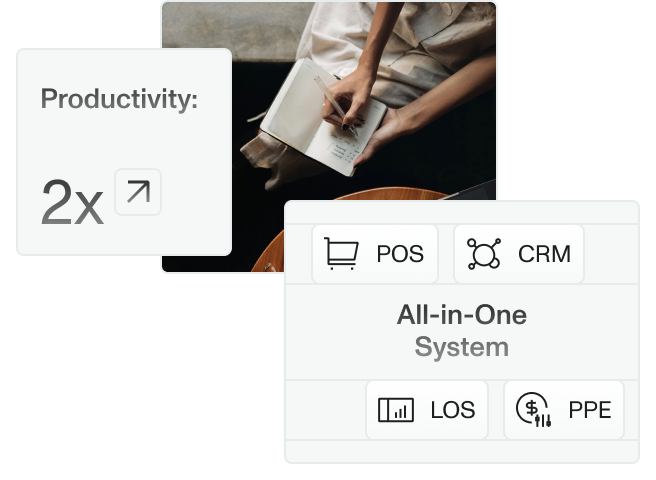For the past few years, the real estate market has been a rollercoaster of prices, inventory levels, and new trends, all vying for attention. While the market is far from stabilized, 2023 ended the tumult.
High interest rates keep homes off the market and discourage new buyers. Many experts believe the sluggish situation will continue throughout 2023, as interest rates will likely fall in Q2 next year at the earliest.
As a mortgage broker, you must stay informed about the most recent market trends to ensure your pipeline can take advantage of what’s in store. Doing so allows you to recognize and act on potential opportunities, anticipate risks, and move towards more secure investments.
The State of the Housing Market: July 2023
As of July 7, 2023, the average interest rate for a 30-year fixed-rate home loan is 6.81%. This increase is up from 6.71% a week ago.
Meanwhile, inventory levels remain low, with half of what experts believe would be necessary to meet demand. The reduced supply has pushed many buyers out of the market, but activity has slowed partially. The median time on the market was 44 days in June, showing that the market is still competitive.
High interest rates, high inflation, and low supply influence the current housing market. Inflation, such as the PCE and Consumer Price Index, surpasses the government’s 2% target. This inflationary pressure impacts buyers’ purchasing power and can further intensify affordability challenges in the housing market.
Will Rates Continue to Rise?
Despite the recent increase in interest rates, many experts don’t see much change on the horizon. The Federal Reserve has signaled its intention to keep inflation levels low, which means that mortgage rates are unlikely to fall significantly in the next few months.
However, gradual rate increases may continue. The US economy is still far from recovered, and if inflation isn’t curbed, it could trigger a further wave of mortgage rate hikes. If inflation tampers down, rates could stabilize or decrease slightly in Q3 and Q4.
“Mortgage rates continued their upward trajectory again this week, rising to the highest rate this year so far,” Freddie Mac’s Chief Economist said on July 6. “This upward trend is driven by a resilient economy, persistent inflation, and a more hawkish tone from the Federal Reserve.”
It’s also important to remember that mortgage rates are not necessarily driven solely by economic factors. Political shifts, natural disasters, and other events can all contribute to rate changes.
Will Prices Rise or Fall?
The outlook for home prices is murkier. Low inventory and high demand can lead to price increases. A rising interest rate environment could reduce affordability and dampen price growth. Ultimately, prices will stay relatively flat or decline in some areas.
Inventory has remained low all year. However, there is some activity in construction. New home sales grew 20% year-over-year in 2023, while existing-home sales fell significantly. Single-family construction starts jumped 18.5% in April alone, matching a rise in builder confidence. The June National Association of Home Builders (NAHB)/Wells Fargo Housing Market Index rated builder sentiment higher than it has been in 11 months.
Still, with high purchasing costs, many would-be homebuyers are waiting for a more favorable situation. First-time buyers, for example, only represented 26% of the market in 2022, compared to 34% in 2021. The downward trend continued into 2023.
Homeowners looking to refinance are in a similar situation. As interest rates reach 7%, many borrowers may get priced out of refinancing.
The Biggest Changes in the Housing Market
One of the most significant changes this year has been the introduction of new mortgage rules to help first-time and low-credit buyers. Implemented on May 1st, the mortgage pricing updates affect borrowers who apply for conventional loans backed by Freddie Mac or Fannie Mae.
Explore our guide to Fannie Mae and Freddie Mac Loans
Borrowers with high credit scores and large down payments still pay lessened fees. However, the new rules decrease fees for borrowers with scores less than 680. Borrowers with a 630 score and a 5% down payment are now responsible for a 1.75% upfront fee. Previously, they would have to pay 3.5%
Some borrowers with high credit scores are negatively affected by the change. A borrower with a 20% down payment and a 740 credit score will now pay 0.875% in fees rather than 0.5%.
Preparing for The Second Half of 2023
The uncertainty of the housing market means that originators need to prepare for any eventuality. Risk management is vital, and originators should look for ways to reduce risk while facilitating growth.
Here are some strategies to help you navigate the second half of the year:
- Keep an eye on inflation and interest rate movements. Use forecasts from reliable sources such as Freddie Mac to anticipate potential changes in market conditions.
- Be flexible. Look for ways to adjust your strategy to shifting conditions, such as targeting specific borrowers or using technology to increase efficiency.
- Broaden your reach. Consider expanding your product offerings and/or target markets to capture more business.
- Upgrade your system. Using a legacy LOS will slow you down and alienate customers. Switch to an advanced, all-in-one system like Sonar instead.
Ready to transform your mortgage operations? Schedule a demo of the world’s first mortgage experience platform now!
Success in Mortgage Includes Sonar
Despite the uncertainty surrounding the housing market, one thing is clear: staying informed and proactive is essential.
Utilizing technology like Sonar will help you prepare for whatever changes come your way. This system allows originators to stay organized, streamline their processes, and even provide customers with a high-tech experience that can put them at ease during stressful market conditions.
The latter half of 2023 is an ideal time to improve your strategy and adopt a new mortgage LOS. The market will likely increase significantly after the new year due to economic factors like inflation and natural elements like time of year and seasonality. Families, for instance, are reluctant to move right after the school year starts.
Integrating Sonar into your system gives you extra time to familiarize your team before business picks up again. Doing so will help you hit the ground running when the market starts to move again.
Set yourself up for success with our all-in-one mortgage solution. Get started today!








